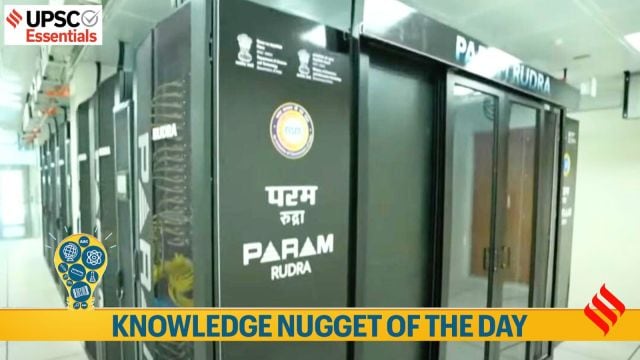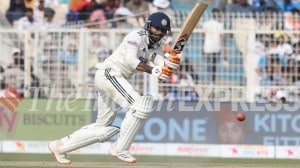
Knowledge Nugget: PARAM Rudra
Subject: Science and Technology
Why in news?
Three new supercomputers, installed at premier scientific institutions in Delhi, Pune and Kolkata, to boost research in the fields of astronomy, medicine and high-energy physics, were on Thursday dedicated to the nation by Prime Minister Narendra Modi.
Story continues below this ad
Key Takeaways :
1. PARAM Rudra Supercomputers are developed indigenously by the Centre for Development of Advanced Computing (C-DAC) under the National Supercomputing Mission (NSM).
2. Supercomputers have been deployed in Pune, Delhi, and Kolkata to support groundbreaking scientific research.
(i) Giant Metre Radio Telescope (GMRT) in Pune: It will utilize the supercomputer to study Fast Radio Bursts (FRBs) and other astronomical phenomena.
(ii) Inter-University Accelerator Centre (IUAC) in Delhi: It will advance research in fields such as material science and atomic physics.
(iii) S.N. Bose Centre in Kolkata: It will drive advanced research in areas including physics, cosmology, and earth sciences.
Story continues below this ad
3. The most powerful of these is the one installed at IUAC which has 3 petaflop capacity. GMRT has got one petaflop supercomputer, while the one at S N Bose institute has a capacity of 838 terraflops.
4. In addition, the computing power available for weather and climate research has been significantly upgraded by the setting up of High-Power Computing (HPC) systems the two atmospheric sciences institutes, one in Pune and the other in Noida, which already have a supercomputer each.
5. Arka system at IITM has a 11.77 Peta Flop capacity and will, for the first time, help improve the country’s horizontal resolution of its global weather prediction models to 6 km from the existing 12 km. HPC Arunika comes with a 8.24 Peta Flop capacity. This HPC will prove beneficial in upgrading weather forecast resolution at block levels.
JUST FYI: The country is also taking the lead in quantum computing where the National Quantum Mission is playing a crucial role in advancing India’s position in this cutting-edge technology.
Story continues below this ad
BEYOND THE NUGGET: National Supercomputing Mission, FLOPs, petaFLOP & National Quantum Mission
1. The National Supercomputing Mission (NSM) was launched in 2015 to connect national academic and research and development institutions with a grid of high-performance computing facilities.
2. NSM is jointly managed by the Department of Science and Technology (DST) and the Ministry of Electronics and IT (MeitY). It is implemented by the Centre for Development of Advanced Computing (C-DAC) in Pune and the Indian Institute of Science (IISc) in Bengaluru.
3. The mission aims at creating a powerful supercomputing capability for the country and offer powerful computational facilities to boost research. The main objectives of the mission are:
— Make India a world leader in HPC and to enhance the national capability in solving grand challenge problems of national and global relevance.
Story continues below this ad
— Empower scientists & researchers with state-of-the-art compute facilities for their cutting-edge research in respective Domains.
— Reduce redundancies and avoid duplication of efforts and investments
— Create an ecosystem for positioning India as a major power for supercomputing and attain global competitiveness and self-reliance in HPC
4. The mission was planned in three phases with phase I looking at assembling supercomputers, phase II looking at manufacturing certain components within the country, and phase III where a supercomputer is designed by India.
National Quantum Mission
Story continues below this ad
1. India in 2023 announced the setting up of the National Quantum Mission to build capabilities in quantum-related science and technology. The mission focuses on four key domains: computing, communications, sensors, and materials.
2. The Mission has an outlay of Rs 6,003.65 crore, which will be used to fund the scientific and industrial research projects for eight years (2023-2031). It includes the establishment of four thematic hubs (T-Hubs) dedicated to the four domains or verticals. Each vertical will have its own goals and challenges. Before exploring each vertical, let us first understand what is quantum technology.
FLOPs in Computing
FLOPs, or Floating-Point Operations per Second, is a commonly used metric to measure the computational performance – processing power and efficiency – especially in the field of high-performance computing (HPC) and artificial intelligence (AI). Floating-point operations are a certain kind of mathematical calculation using real numbers with fractional parts.
FLOPs is not the only factor determining the performance of a computing system. Memory bandwidth, latency, and other architectural features also play significant roles. Nonetheless, FLOPs provide a valuable baseline for comparing the computational capabilities of different systems, especially in tasks where floating-point calculations dominate.
petaFLOP
Story continues below this ad
Due to the immense computing power of today’s computers, the FLOPs metric is most often represented in terms of billions (giga), trillions (tera), or even quadrillions (peta) of operations per second (GFLOPs, TFLOPs, PFLOPs, respectively). A petaflop is thus equal to a thousand TFLOPs or 1015 FLOPs.
(Sources: dst.gov.in/, meity.gov.in, PM Modi dedicates three new supercomputers to nation)
For your queries and suggestions write at roshni.yadav@indianexpress.com
Subscribe to our UPSC newsletter and stay updated with the news cues from the past week.
Story continues below this ad
Stay updated with the latest UPSC articles by joining our Telegram channel – Indian Express UPSC Hub, and follow us on Instagram and X.


































